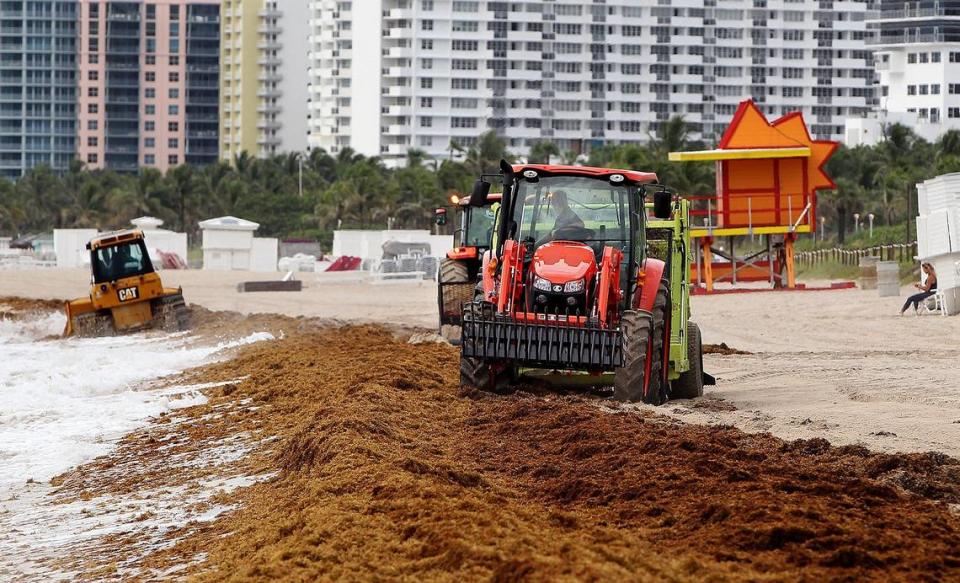A good seaweed surprise for Florida: Floating mass has actually shrunk, reasons unclear
South Florida beaches — and all the people who flock to them — may catch a break from a much-hyped and dreaded onslaught of seaweed this summer.
Scientists have spotted a mysterious decline in the 5,000-mile wide seaweed belt floating across the Atlantic Ocean and Caribbean Sea. The drop won’t be enough to keep beaches seaweed-free, but it did knock back what had been a record-breaking seaweed bloom.
The Great Atlantic Sargassum Belt — the scientific name for the massive mat of floating brown seaweed that annually washes up on beaches around the Caribbean, Gulf of Mexico and east coast of Florida — shrank 15% last month, according to a University of South Florida research lab that uses satellites to track sargassum.
It’s the first time scientists have seen a sargassum bloom shrink in May, a time of year when the floating algae usually thrives. “This is really unexpected,” said Chuanmin Hu, who is part of the USF research lab that tracks sargassum. “It does not follow any historical trend.”
In their latest monthly sargassum report, Hu and his colleagues predicted seaweed levels in the Gulf of Mexico would fall in June, which, they wrote “should be good news to the residents along the Florida Keys and east coast of Florida.”
That’s because ocean currents tend to carry water, and floating sargassum, out of the Gulf of Mexico, past the Keys and up the east coast of Florida, depositing seaweed on the beaches all along the way. The less seaweed there is floating in the Gulf of Mexico today, the less seaweed South Florida swimmers and sunbathers will have to deal with later this summer.
“This is good news for the Caribbean and for Florida, but that does not mean Florida will be immune to sargassum immediately,” said Hu. “The Florida Keys and Southeast Florida will still get some sargassum in the next few weeks…but we have a much better outlook for the summer.”

Disaster averted
Scientists believe climate change and global pollution from sewage and fertilizer are to blame for a string of record-breaking summer sargassum blooms since 2011. Warming oceans and extra phosphorus and nitrogen in the water turbocharge the growth of sargassum (along with other algaes that cause red tides and fish kills).
This year’s sargassum bloom had been on pace to reach record-breaking size as recently as April. “A couple months ago, I was actually scared, because for a few consecutive months the amount of sargassum was a record high compared to all previous years,” Hu said. “I said, ‘Wow, this is very bad. If this trend continues…this will be a disaster when we enter the summer.’”
“Thank god that did not happen,” Hu said.
Scientists aren’t sure what caused the sudden reversal last month. “The reasons behind such a sharp decrease remain to be investigated,” the USF researchers wrote in their monthly sargassum report. Hu said it could take months or years to figure out what happened.
Sargassum levels are still high
Despite the downturn, sargassum levels are still unusually high compared to historical averages. This year’s bloom is still bigger than most of the abnormally big sargassum blooms scientists have tracked since 2011, and Floridians can still expect to see some seaweed piling up on their local beaches.
But at least, for now, we’re no longer on pace to see the worst seaweed season in living memory this summer.
“We just entered the summer and we see good signs of decreasing sargassum,” Hu said, predicting that the seaweed outlook should be “good for the whole summer.”
Then he paused. “Unless I’m wrong,” he said. After all, he said, last month he predicted sargassum levels would increase in May, and instead they fell. “Most of the time I’m right, but I’m not always right.”
This climate report is funded by Florida International University, the Knight Foundation and the David and Christina Martin Family Foundation in partnership with Journalism Funding Partners. The Miami Herald retains editorial control of all content.

